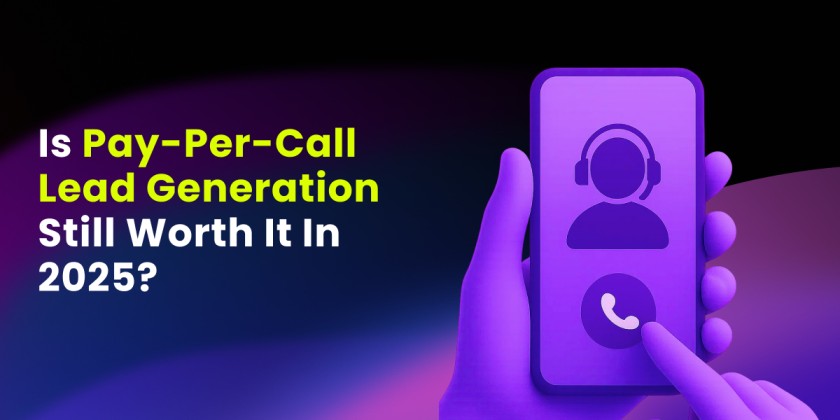Are your website visitors leaving without taking action? The difference between bounces and sales often comes down to one thing: powerful conversion copywriting.
Unlike standard content writing that merely informs or entertains, conversion copywriting is purposefully crafted to drive specific actions, whether that’s clicking a button, signing up for a free trial, or making a purchase.
In today’s digital landscape, where attention spans are shrinking and competition is fierce, mastering conversion copywriting isn’t just helpful—it’s essential for business survival. You can drive all the traffic in the world, but without a strong copy, it won’t convert, making it nearly impossible to reach standard landing page conversion benchmarks.
Through real-world examples and actionable strategies, you’ll transform your website copy from passive content into a powerful sales machine that turns casual browsers into loyal customers.
Jump to Section:
🚀 KEY TAKEAWAYS
- Conversion copywriting is all about crafting messages that drive readers to take specific actions, such as making a purchase or signing up for a service.
- Effective conversion copy focuses on clear value propositions,benefit-driven language, and powerful calls to action that remove friction and encourage users to act.
- Understanding your audience and crafting copy that speaks directly to their needs, desires, and pain points is critical to successful conversion copywriting.
- Utilizing psychological triggers like urgency and scarcity, along with providing social proof, can significantly increase the effectiveness of your conversion copy.
- A/B testing and continual optimization of your copy ensure that your messages are always improving and driving better results over time.
What is conversion copywriting?
Conversion copywriting is an uncommon form of writing whose sole purpose is to encourage the reader to do something immediately: buy a product, subscribe to a newsletter, or download a guide.
Conversion copywriting is written with the intent to take the reader down the path of persuasion so that it is easy for him or her to comprehend the value of a product or service and answer all the questions and doubts he or she would otherwise have.
At its very essence, conversion copywriting isn’t necessarily about writing convincing words. It’s about positioning your copy in correspondence with people’s psychology to come across naturally and resonate, compelling the reader to take your desired action.
Key Elements of Conversion Copywriting
Clarity Over Cleverness
While creative language can appeal, conversion copywriting focuses on crystal clarity. Users need to understand immediately what you’re offering and how it benefits them. Complicated or ambiguous messaging can lose potential leads before they even get started.
Audience-Centric Approach
Conversion copywriting lives and dies on deep audience insight. It’s writing within the reader’s voice and delivering highly applicable answers, remembering what they need at a given time. This means constant research to comprehend their issues, wishes, and aspirations.
Value Proposition Front and Center
The value proposition is the essence of all winning conversion copy. It is your commitment to the reader regarding what he will gain through your service or product. Rather than repeating features, conversion copywriting needs to consider why the features matter and how they will help resolve the reader’s problem.
Psychological Triggers
Successful conversion copywriting invokes emotional triggers like scarcity, urgency, and social proof to lead individuals into taking prompt action. The triggers employ emotions and leverage the feeling of FOMO (fear of missing out) or impose trust using consumer reviews or third-party endorsements.
Words have power, but imagery and affectively laden words enhance the writing.
People are emotive decision-makers, and conversion copywriting incorporates language that touches logic and emotion. This may involve highlighting how your service or product makes the reader feel empowered, relieved, or excited.
Successful Calls to Action (CTA)
A CTA is the most critical component of any conversion copy.
This is where you instruct your audience what to do next. A clean CTA creates clarity, a feeling of importance, and a clear next step.
Rather than dull CTAs such as “Click here,” you must inform the reader using action verbs such as “Start your free trial now” or “Get instant access.”
Why Conversion Copywriting is a Game-Changer for Your Business
Conversion copywriting is the essence of converting visitors into long-term customers. It enables companies to communicate the product’s worth clearly and persuasively, emphasizing the action that the company needs its target market to take immediately.
Whether you are drafting landing pages, email campaigns, or advertisements, conversion copywriting enables you to lead your audience through a streamlined process that results in increased sales, engagement, and retention.
The beauty of conversion copywriting is its adaptability. It works for any stage of the customer journey, whether you’re trying to convert cold traffic into leads or close sales with prospects who are already interested in your product.
🚀 Ready to Turn Copy Into Conversions?
Build high-converting landing pages with LanderLab. No coding required.
Step-by-Step Process to Conversion Copywriting
Great conversion copy isn’t created by accident—it’s engineered through research, psychology, and strategic thinking. Follow this comprehensive framework to create copy that doesn’t just sound good but actually drives results.
1. Audience Research: Develop a Customer Empathy Map
Standard audience research only scratches the surface. Create a comprehensive customer empathy map by:
- Conducting voice-of-customer research: Collect exact phrases customers use when describing their problems. These “golden nuggets” should be incorporated verbatim in your copy.
- Analyzing the before and after states: Document precisely what your customer’s life looks like before your solution and after implementing it—emotionally, financially, and professionally.
- Building psychological profiles: Beyond demographics, identify the core emotional drivers and decision-making patterns of your audience. Are they analytical decision-makers who need data, or intuitive buyers who respond to stories?
- Mapping objection patterns: Document every possible objection in your customer’s mind and categorize them by type: price concerns, implementation fears, trust issues, or status quo bias.
Pro tip: Create actual customer personas with quotes from real conversations. For example, “I was spending 15 hours weekly on reporting before finding your solution” is infinitely more valuable than generic pain point assumptions.
2. Define Your Copy’s Strategic Intent: The Conversion Triangle
Every piece of conversion copy needs to balance three elements of the “Conversion Triangle”:
- Desired Action: Define exactly what micro-commitment or macro-conversion you want the reader to take—be incredibly specific about this action.
- Motivation Alignment: Identify which specific customer motivation your copy will tap into (desire for status, fear of missing out, need for security, etc.).
-
Friction Reduction: List all potential sources of psychological friction preventing action and address each one directly.
Implementation example: For a B2B software signup page, your triangle might look like:
-
Action: Complete a 5-field signup form for a product demo
-
Motivation: Fear of falling behind competitors who are using automation
-
Friction: Concerns about time investment in learning new software
Your copy must simultaneously activate the motivation while dissolving the friction to drive the action.
3. Engineer Your Headline Framework: The 4U Formula
Don’t just write catchy headlines—engineer them using the proven 4U formula:
-
Useful: How does your headline promise practical value?
-
Urgent: What time-sensitive element creates immediacy?
-
Unique: What distinguishes your offer from everything else?
-
Ultra-specific: What precise details make your headline concrete?
Practical application:
Transform “Get More Website Traffic” into “Generate 37% More Qualified Leads in 30 Days—Without Increasing Your Ad Spend” (useful + urgent + unique + ultra-specific).
Test multiple headline variations that emphasize different elements of the 4U formula to discover which resonates most with your audience.
4. Structure Your Body Copy with the PASTOR Framework
Effective body copy follows a proven persuasive structure:
-
Problem: Articulate the problem more clearly than the customer can themselves
-
Amplify: Increase the emotional stakes of not solving the problem
-
Story/Solution: Present your solution through narrative that demonstrates transformation
-
Testimony: Provide evidence from others who have succeeded
-
Offer: Present your specific offer with clear terms
-
Response: Request immediate action with clear next steps
Implementation tip: For each section, write three different versions: one logical/analytical, one emotional/narrative, and one hybrid. Test which performs best with your audience.
5. Emotional Resonance Mapping: Trigger the Right Feelings
Before persuading logically, your copy must connect emotionally. Use emotional resonance mapping to:
-
Identify the dominant emotional motivators for each persona (e.g., relief, status, fear of failure)
-
Choose the language that mirrors those emotions—use words that express their inner dialogue
-
Layer empathy throughout copy, especially at the beginning and in key objections
-
Match emotional tone to funnel stage (awareness = empathy; decision = confidence and certainty)
Emotional connection increases reader engagement and boosts conversion readiness.
6. Information Hierarchy & Flow: Write for Scanners
Structure your page so it flows logically and scannably:
-
Lead with the value proposition
-
Support with empathy and relevance
-
Break down benefits and features in digestible blocks
-
Add visual anchors (subheadings, bullets, bold) for readers who skim
-
Create flow between sections using transitions and micro-conversions
A smooth narrative flow reduces friction and guides the reader naturally toward conversion.
7. Implement Scientific Testing: The Conversion Matrix
Move beyond basic split testing of your landing page with the conversion matrix approach:
-
Element isolation: Test one variable at a time (headline, testimonial placement, CTA color)
-
Multivariate mapping: Document how variables interact with each other
-
Segment-specific results: Analyze how different audience segments respond to the same copy
-
Heatmap integration: Connect user behavior data with actual copy changes
-
Win/loss analysis: For each test, document why the winning version succeeded
Advanced implementation: Create a “copy testing calendar” that systematically rotates through testing different elements on a regular schedule, ensuring continuous improvement.
Conversion Copywriting Formulas
Ever wondered how the pros consistently write copy that converts? They’re not reinventing the wheel each time—they’re using proven formulas that work time and again. These frameworks give your copy structure while ensuring you hit all the psychological triggers needed to drive action. Check out these affiliate landing page examples to see how top performers apply them in real campaigns.
PAS (Problem-Agitate-Solve) is perhaps the most powerful formula in conversion copywriting. Start by identifying a specific problem your audience faces. For example, “Struggling to get visitors to take action on your website?” Then agitate that problem by digging into the pain it causes: “Every day those visitors leave means lost revenue, wasted ad spend, and watching competitors capture the customers that should be yours.” Finally, present your solution: “Our conversion optimization service transforms passive visitors into active customers with proven strategies tailored to your audience.”
AIDA (Attention-Interest-Desire-Action) is the classic marketing framework that still works wonders today. Grab attention with an eye-catching headline or shocking statistic. Build interest by connecting features to benefits. Create desire by painting a vivid picture of life with your product. Then, prompt specific action with a clear, compelling CTA. The beauty of AIDA is its versatility—it works for everything from emails to landing pages to social media ads.
BAB (Before-After-Bridge) speaks directly to transformation, which is what customers really want. Describe their current situation with all its frustrations: “Right now, writing sales pages takes you hours and still doesn’t convert.” Then paint the picture of the ideal outcome: “Imagine creating high-converting copy in half the time, with confidence that it will drive sales.” Finally, bridge the gap by showing how your product gets them there: “Our copywriting templates provide proven structures that eliminate guesswork and boost conversion rates by an average of 27%.”
4 Ps (Promise-Picture-Proof-Push) builds credibility into your conversion journey. Start with a compelling promise: “Double your email open rates in 30 days.” Create a vivid picture of the benefit: “Imagine watching your analytics show twice as many people engaging with every email you send.” Provide solid proof it’s possible: “Just like our client Sarah, who increased opens by 137% using these exact techniques.” Finally, push for action: “Grab the Email Engagement Blueprint now to transform your results this month.”
Using these formulas doesn’t mean your copy will sound formulaic. Think of them as reliable structures you can infuse with your brand voice, compelling stories, and unique value proposition to create copy that consistently converts.
By tailoring your conversion approach to these industry-specific needs, you’ll connect more deeply with prospects who will recognize that you truly understand their unique challenges and opportunities.
13 Real-Life Examples of Conversion Copywriting
1) Dropbox
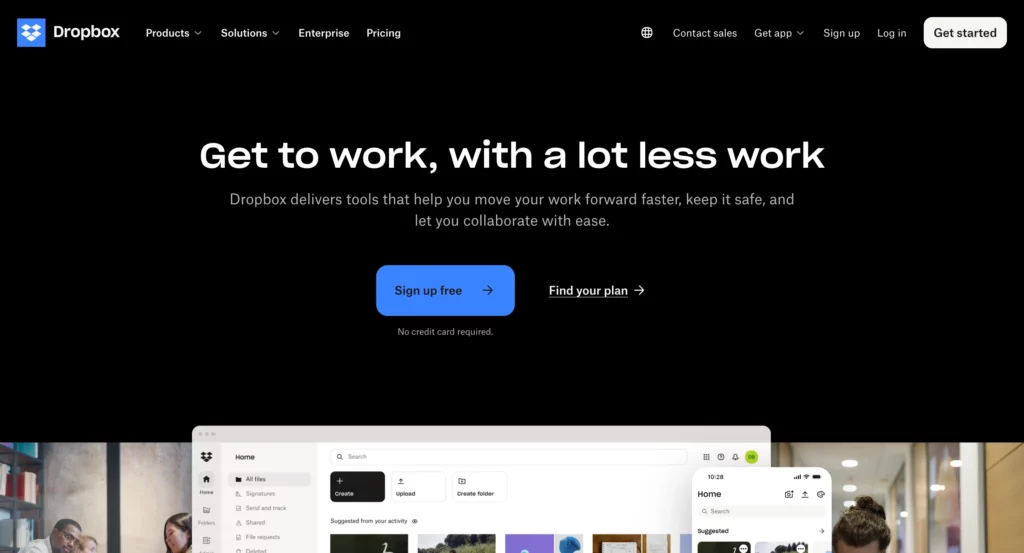
Headline: “Get to work, with a lot less work”
Dropbox grabs attention instantly by appealing to the reader’s desire to be organized. Being organized is essential in today’s busy work life to be productive. By employing the phrase “more organized,” Dropbox highlights the fact that its product makes companies more productive. This straightforward, benefit-oriented headline communicates the value proposition effectively.
Why It Works
Benefit over feature: Dropbox does not mention the technical features here (e.g., storage capacity or file types). Instead, it emphasizes the benefit of easy collaboration. This is far more convincing because it informs the user of the desired result: ease and efficiency.
Simplicity and clarity: The words are simple and easy to grasp. There are no complicated explanations and jargon here, just plain value statements detailing how Dropbox facilitates company organization and collaboration.
Emotional appeal: Words like “seamless” evoke emotions, highlighting less stress and better workflow.
Call to Action (CTA):
“Sign up free”
Why it Works:
- Action-oriented: The CTA is direct and tells the user exactly how to start a trial. It invites users to experience the product risk-free, which reduces friction.
- Risk-free offer: By highlighting the “free trial” with no immediate commitment, Dropbox encourages users to take the first step without hesitation. This lowers the barrier for those who may be hesitant about paying upfront without trying the product.
2. Canva

Headline:
“What will you design today?”
Why it Works:
The title is short, concise, and very compelling. It immediately sparks the reader’s imagination and addresses the possibility of personal or corporate projects. The open-ended question challenges the reader to think about what they can do with the tool.
Adding “today” gives a sense of urgency, pushing the user to begin now and not later.
Actionable Insight: This is an effective type of headline because it identifies one action (designing) and empowers users to visualize what they can create immediately. It’s extremely motivating.
Body Copy:
“With Canva, you can design, generate, and work on anything.”
Why It Works:
Clear value proposition: This text describes Canva in a few plain words. Using words such as “design,” “create,” and “work on anything,” it conveys the platform’s wide-reaching flexibility. Canva is useful for personal projects, professional presentations, social media photos, etc.
Broad appeal: It’s not just for designers but for anyone needing creative software, from students to professionals.
Simplicity: The content is concise and clear, stating Canva’s versatility without bombarding the reader with technical terminology.
3. Moosend
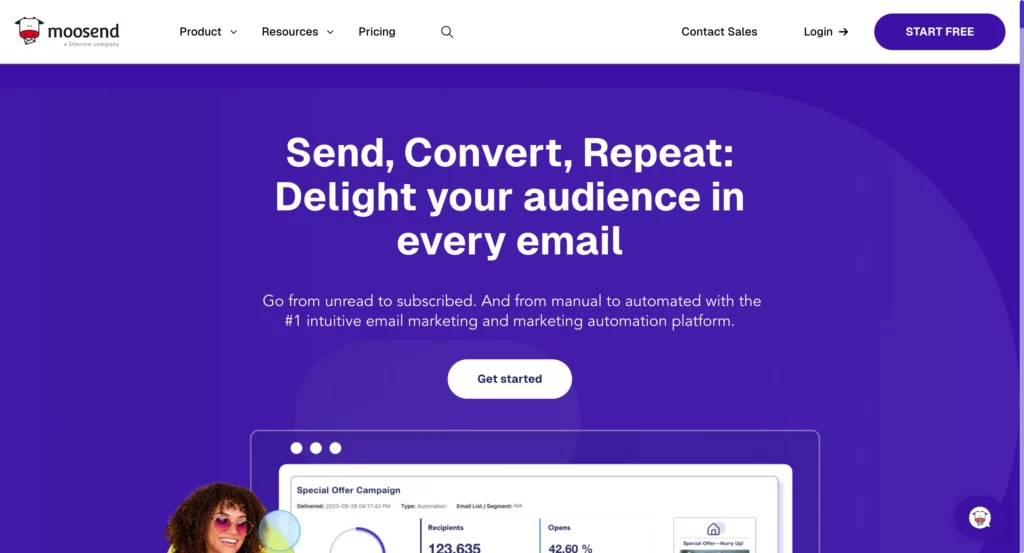
Headline:
“Send, Convert, Repeat: Delight your audience in every email”
Why it Works:
Moosend’s tagline is unique in that it presents its service as a process—send, convert, Repeat—which directly reacts to the main activities of email marketing. Including “Delight your audience” brings an emotional tone, not just reacting to sending emails but to getting quality content that delights and resonates with recipients.
Actionable Insight: This one succeeds because it succinctly points out the fundamental advantages (sending, converting, and repeating) and addresses the reader’s wish to make significant connections with their public.
Body Copy:
“Go from unread to subscribed. And from manual to automated with the #1 intuitive email marketing and marketing automation platform.”
Why It Works:
Problem-solving approach: The copy starts by citing a universal issue that email marketers encounter, bouncing emails from “unread” to “subscribed.” This immediately strikes their pain points.
Benefit-oriented language: The transition from manual to automatic highlights Moosend’s efficiency, and the reader can immediately understand how the platform will save them effort and time.
Authentic statement: By referring to itself as the “#1 intuitive email marketing and marketing automation platform,” it is using social proof to advance its own company as a top-of-the-line brand in its field, increasing credibility.
4. Evernote
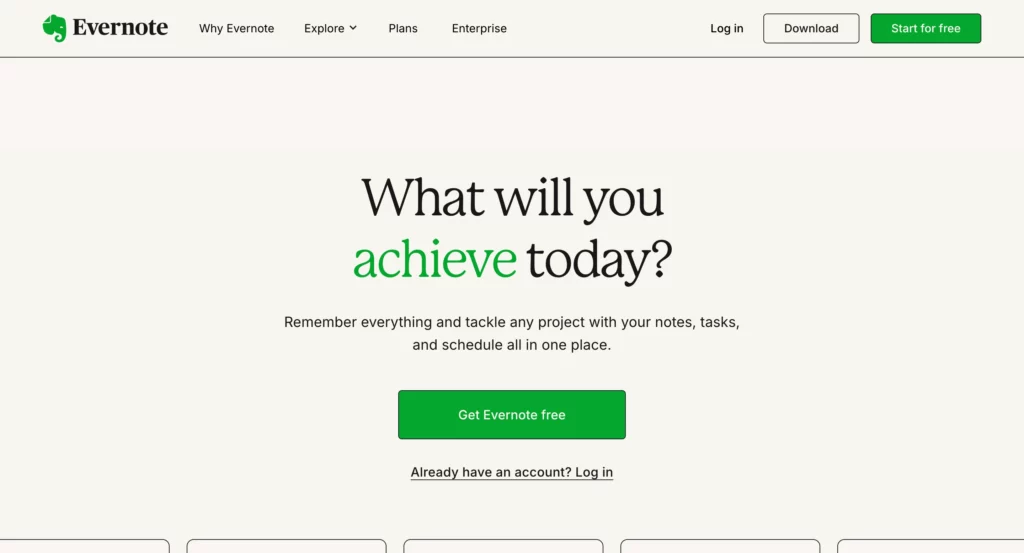
Headline:
“What will you achieve today?”
Why it Works:
Evernote’s caption asks the user a question to consider what they want to achieve today. The word “achieve” is inspirational and sets the user immediately in contact with their motivation to be productive and organized. It transforms Evernote from an application into something else; it’s placed within the realm of a means for success. The fact that the question is open-ended generates curiosity and self-involvement.
Actionable Insight: This is effective because it satisfies the reader’s motivation for success. It doesn’t simply state what Evernote can do but urges them to imagine their productivity, which is a potent emotional stimulus.
Body Copy:
“Remember everything and tackle any project with your notes, tasks, and schedule all in one place.”
Why It Works:
Transparency of value proposition: Evernote’s body copy clearly summarizes the main advantage in a short sentence: It helps people remember everything and remain organized by combining notes, tasks, and calendars. This matters to individuals tired of juggling multiple tools for different aspects of their lives.
Emotional appeal: The word “tackle any project” inspires, suggesting that customers will have the capability and mastery to overcome any task through Evernote.
Simplicity: It is short and straightforward, summarizing the advantages in one sentence with no filler.
Call to Action (CTA):
“Get Evernote free”
Why it Works:
Actionable: The CTA is short and instructs users what to do next. “Get Evernote free” is a high-reward, low-risk phrase. It makes it crystal clear that the user can try the tool risk-free, reducing the barrier to use.
Value proposition: Providing Evernote for free offers potential customers a risk-free opportunity to try the product and see its value.
Use of color: The green button emphatically stands out against the background, highlighting it and inviting users to click.
5. Netflix
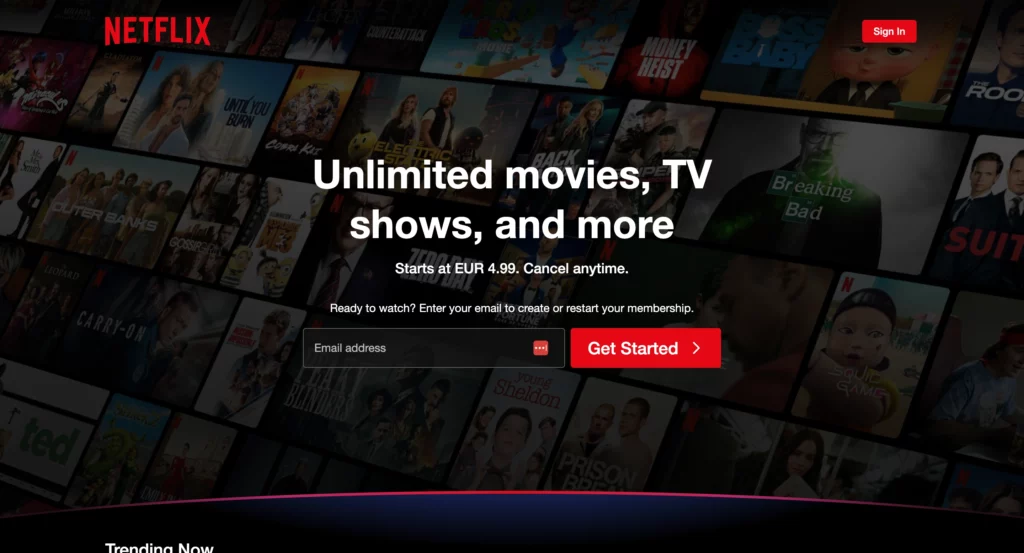
Headline:
“Unlimited movies, TV shows, and more”
Why it Works:
Netflix’s brief motto clearly conveys its fundamental principle of endless entertainment. “And more” is deliberately cryptic but incredibly enticing. The implication is that Netflix has something additional to offer beyond movies and television shows; there’s an enormous library to discover.
Actionable Insight: The headline is brief, value-based, and intriguing. It promises that the user can view many different content, which is a great value proposition.
Body Copy:
“From EUR 4.99. Cancel anytime.”
Why It Works:
Price transparency: Placing the starting price immediately below the headline decreases friction and ensures that potential clients know the cost upfront. It eliminates doubt and builds confidence.
Flexibility appeal:
Employing “Cancel anytime” abolishes the conventional criticism of subscription-based products, the fear of commitment. It assures consumers they are not tied to a contract, reducing sign-up barriers.
Call to Action (CTA):
“Get Started”
Why it Works:
- Action-oriented: The CTA is simple and directly instructs the user to take the next step. There’s no confusion about what happens next.
- Urgency and ease: “Get Started” is a compelling, action-driven verb that makes signing up feel easy and immediate.
6. LanderLab (Landing Page Builder for Affiliates)

Headline:
“Create High-Converting Landing Pages for Affiliates”
Why it Works:
LanderLab is an extremely specific name that names its target customer affiliates. Including the term “high-converting” next to “landing pages,” it instantly conveys the value proposition of assisting users in creating successful landing pages that have been optimized to convert.
Referencing “affiliates” specifically targets a niche audience, making the message more pertinent.
Actionable Insight: The combination of specificity (“for affiliates”) and value proposition (“high-converting”) resonates with affiliate marketers’ pain points about requiring good landing pages to increase conversions.
Body Copy:
“Do it all visually by yourself – no need to hire a developer or write any code.”
Why It Works:
Convenience: It makes it more convenient by solving the popular headache of requiring tech skills to assemble landing pages.
LanderLab addresses this by allowing consumers to create landing pages without a developer, making it easier.
Benefit-oriented: Highlighting doing all this “visually by yourself” resonates with customers seeking ease and being in control of their landing page building process.
Reassures future users: LanderLab eliminates any hesitation or perceived obstacle by eliminating technical skill as a requirement.
Why it Works:
Easy and engaging: The CTA is short and doable, urging users to proceed with “Get Started.” The added bonus of “It’s free” decreases the entry barrier, which is a wonderful way to motivate users to act now.
Low commitment: Providing a risk-free entry point is attractive to those who do not feel comfortable paying money first without familiarity with the product. This strategy increases conversions because it eliminates risk.
7. TheOptimizer (Search Arbitrage Guide)
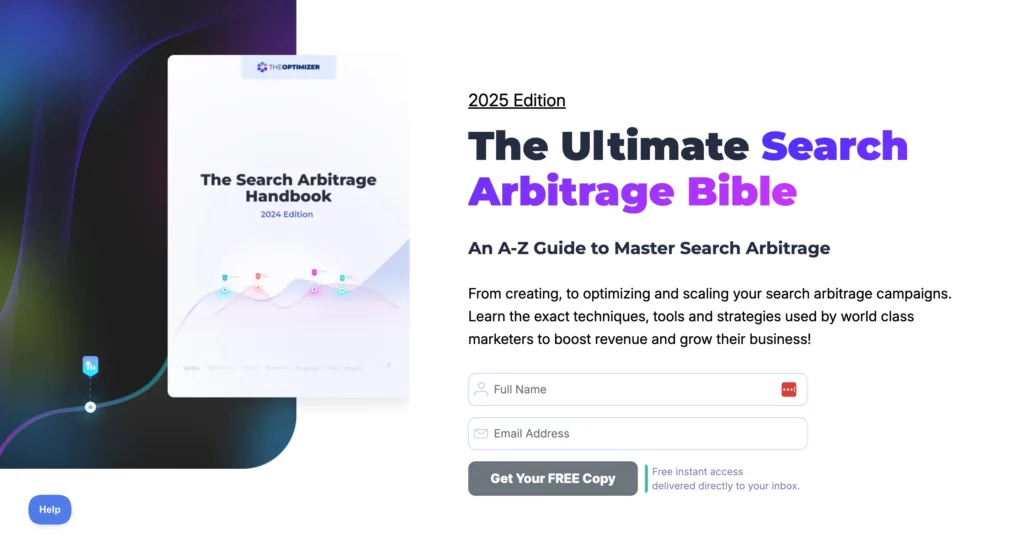
Headline:
“The Ultimate Search Arbitrage Bible”
Why it Works:
This title actually positions the guide as the be-all and end-all for knowledge of search arbitrage, using strong vocabulary like “ultimate” and “bible” that invoke a sense of authority and entirety.
Using the word “Bible” here indicates that this guide is not a mere standard work but rather a conclusive resource for gaining an education about the subject.
Actionable Insight: A focus with strong and bold words such as “Ultimate” and “Bible” captures attention and builds credibility immediately. It entices marketers looking for the best possible tool to become experts in search arbitrage.
Subheadline:
“An A-Z Guide to Master Search Arbitrage”
Why It Works:
The subhead supports the headline’s promise by asserting this is a full A-to-Z guide. The “A-Z” is conducive to containing all necessary to succeed, so it sounds complete and definitive.
Actionable Insight: Such precision at the subheadline level informs the reader that the guide is exhaustive, making it very attractive to someone new to the idea or wanting to learn more. It is a term of promise and totality that urges the user to take action.
Body Copy:
“From creating, to optimizing, and scaling your search arbitrage campaigns. Learn the exact techniques, tools, and strategies used by world-class marketers to boost revenue and grow their business!”
Why It Works:
Benefit-focused language: The copy description explains what is being addressed in the guide and the actual benefit to the user. The attention is on helping the user produce, optimize, and scale the campaign, directly referring to eliminating anyone bothered by search arbitrage issues.
Reference to authority: The mention of “World-class marketers” implies faith in the product and elevates it to the status of authority-sanctioned work.
Outcome-based: The guide estimates its value using words such as “drive revenue” and “grow their business,” emphasizing the anticipated outcome the user will get upon implementing the knowledge.
8. Typeform
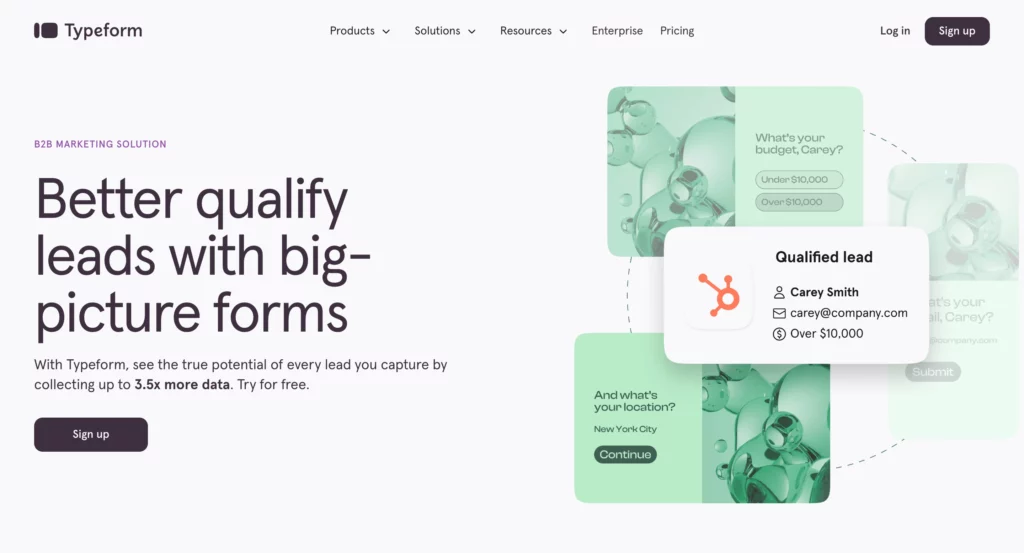
Headline:
“Better qualify leads with big-picture forms”
Why it Works:
Typeform’s title is short and benefit-focused. The words “better qualify leads” resonate with a pain point for B2B marketers, ensuring their leads are properly qualified before they go into the sales process.
Adding “big-picture forms” is catchy and implies that Typeform’s forms do more than collect basic information—they collect useful, detailed information that enables marketers to better understand their leads.
Actionable Insight: This title addresses marketers who wish to enhance the value of their leads. The phrase “big-picture forms” conveys profundity and wisdom, placing the product above average form builders.
Subheadline:
“With Typeform, see the true potential of every lead you capture by collecting up to 3.5x more data. Try for free.”
Why It Works:
Fact-based appeal: That Typeform captures “3.5x more data” in an instant already gives the reader a quantifiable figure in hand. B2B marketers constantly seek to qualify leads better, and the number appeals to the tool’s capability to learn more about each lead.
Low barrier to entry: A free trial is an obvious call to action that minimizes friction. Users get to try the tool for free, which encourages them to sign up and enables them to see the value themselves.
Call to Action (CTA):
“Sign up”
Why it Works:
Simplicity and clarity: The CTA is concise and clear. It tells users exactly what they have to do next, which is critical in conversion copywriting.
No other hindrances: CTA makes the product directly accessible for interaction without overcomplicating it so that the users will find it simple and easy to use.
9. Flodesk’s
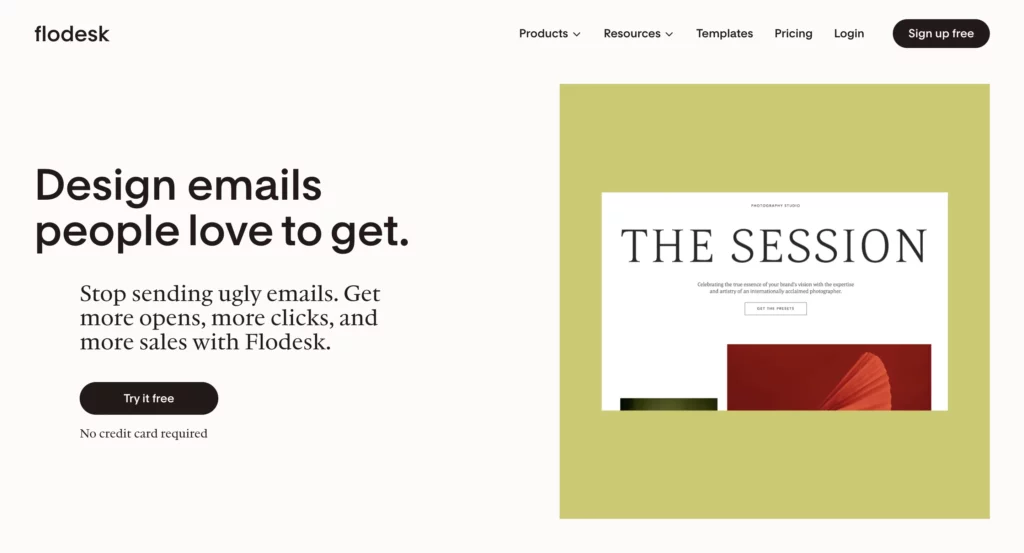
Headline:
“Design emails people love to get.”
Why it Works:
Focused Benefit: Flodesk’s headline message squarely addresses a fundamental pain point, ugly emails, and proposes a solution centered around making people care for them, which is very inspiring to marketers.
Promised Clearly: “People love to get” asserts that the product will facilitate user care and improve email campaigns.
Body Copy:
“Stop sending ugly emails. Get more opens, more clicks, and more sales with Flodesk.”
Why it Works:
Clear and Actionable: The copy employs clear terms to describe the problem (ugly emails) and directly addresses the advantages of more opens, clicks, and sales.
Result-driven: Citing more sales appeals to the bottom line for the marketer, creating revenue.
Call to Action (CTA):
“Try it free”
Why it Works:
Low barrier to entry: A free trial that does not require a credit card to sign up makes it easy for users to test the tool without any commitment, reducing friction.
Simplicity and urgency: The short CTA emphasizes the ease of trying it out for free immediately, guaranteeing immediate action.
10. Grammarly

Headline:
“Responsible AI that ensures your writing and reputation shine”
Why it Works:
Clear and concise: The title refers to the user’s greatest desire for better writing. It is not directly about grammar but about better writing quality, which is universally desired.
Value-based: It results in improved writing quality that appeals to most users, from professionals to students.
Body Copy:
“Work with an AI writing partner that helps you find the words you need—to write that tricky email, to get your point across, to keep your work moving.”
Why it Works:
Specific benefits: The copy mentions specific benefits such as real-time suggestions, tone checks, and grammar correction, showing the users how the tool can enhance their writing.
Call to Action (CTA):
“Sign up It’s free”
Why it Works:
Low-risk offer: The CTA offers a free version of the tool, reducing the barrier to entry for new users who want to experiment with it.
Simplicity and clarity: It is simple and tells the user what to do exactly.
11. Hotjar
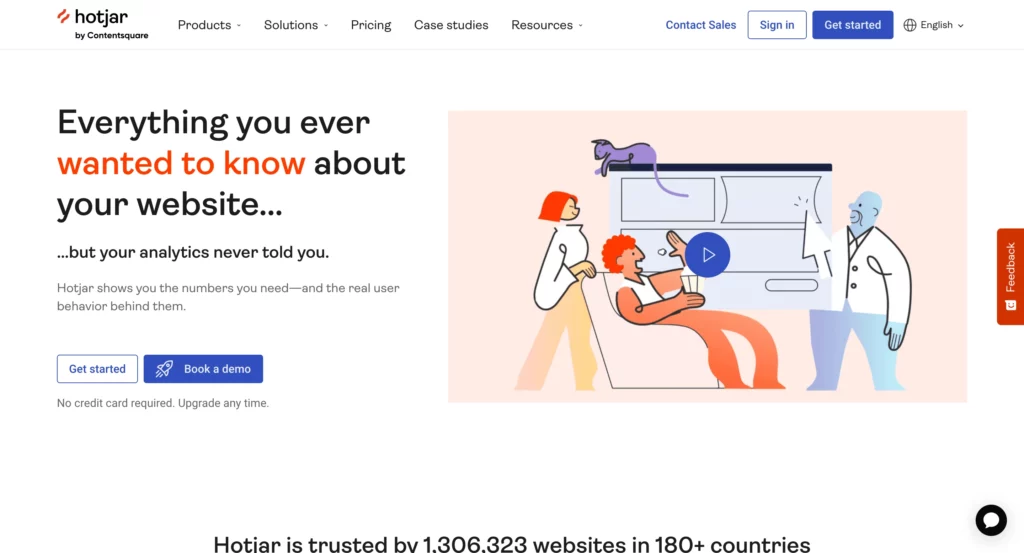
Headline:
“Everything you ever wanted to know about your website…
…but your analytics never told you.”
Why it Works:
Direct value proposition: The title conveys the product’s key benefit of understanding website visitors. This resonates with businesses that want to understand their audience’s behavior.
No jargon: The tone is straightforward and simple, without technical jargon and concentrating on the key benefit.
Subheadline:
“Hotjar shows you the numbers you need—and the real user behavior behind them.”
Why It Works:
Outcome-oriented: The content is about how the tool benefits the user by enhancing the performance of their website, which in turn impacts their business growth.
12. HubSpot:
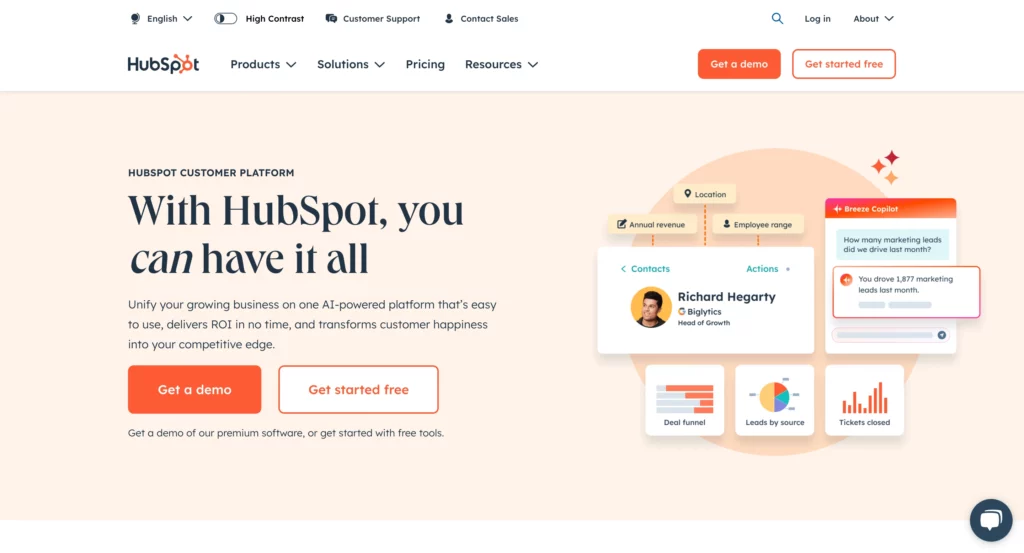
“With HubSpot, you can have it all.”
Why it Works:
Clear and assertive: The reworded headline directly addresses the audience’s need for single-stop solutions.
Subheadline:
“Unify your business operations on one intuitive platform that boosts your ROI, enhances customer experiences, and strengthens your competitive edge.”
Why it works:
Benefit-focused: This subheadline effectively states the key advantages of ROI, customer satisfaction, and competitiveness, providing readers with a compelling reason to keep reading.
Actionable and brief: The subheadline is result-oriented, highlighting results that matter to businesses, including return on investment and customer satisfaction.
13. Asana
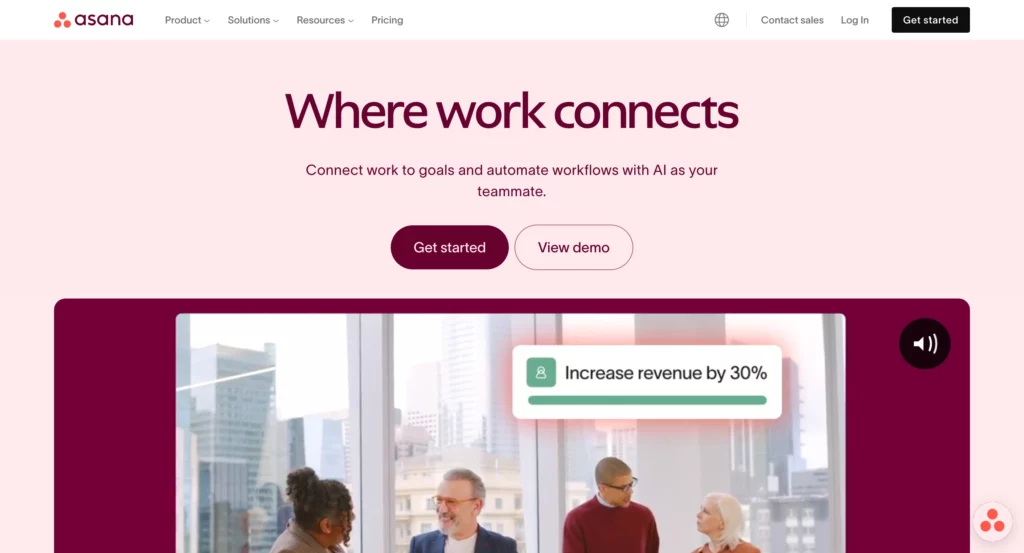
Headline:
“Where work connects—AI-powered project management for better outcomes.”
Why it Works:
Efficient and clean: The label conveys that Asana is not just an operations management solution. It sets AI-powered project management as the value proposition, drawing in those seeking to optimize their processes and results at once.
Conciseness to benefit: Emphasizing “AI-powered” front and center is a massive marketing benefit for contemporary businesses, conveying that Asana is an advanced productivity platform.
Subheadline:
“Connect your team’s work to goals and automate workflows with Asana’s smart tools. Stay on track and achieve more, together.”
Why It Works:
Teamwork emphasis: The headline is about collaboration and being in sync, number one concerns for teams utilizing project management tools.
Intelligent tools and automation: Discussing smart tools and automated processes resonates with teams seeking productivity and doing more, which are the number one drivers for companies using Asana.
Results-oriented: The copy emphasizes being on track and doing more, emphasizing concrete results, which resonates with any team seeking to drive their effectiveness.
Conclusion: Why Conversion Copywriting is Essential
Conversion copywriting is not just a tool; it’s a strategic marketing approach that focuses on achieving real results.
Whether you’re looking to increase leads, drive more sales, or grow your brand’s influence, the right words, combined with a deep understanding of your audience, can make all the difference.
It’s about writing purposefully, ensuring that every line of copy motivates your audience to take action.
Conversion copywriting differs from traditional writing, which may only inform or entertain. Conversion copywriting is the cornerstone of any successful campaign.
It’s what gets people to act, drives them toward buying decisions, and converts website visitors into lifetime buyers.
In today’s competitive market, becoming a conversion copywriting wizard is no longer a luxury but a necessity.
The companies that win are the ones that reach their customers through compelling, powerful messaging that resonates with their needs, fears, and desires.
As you create your conversion copy, remember that it’s not simply about persuasion. It’s about building authentic relationships that leave your audience feeling certain, well-informed, and ready to take action.
With the proper techniques and mindset, you can translate fantastic copy into tangible business success.




